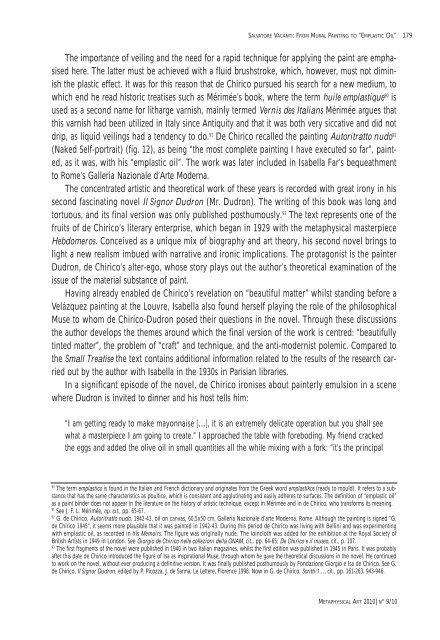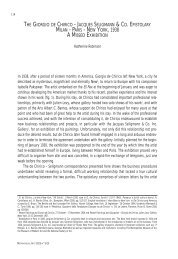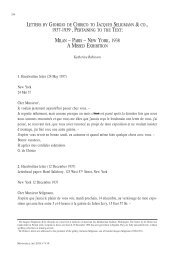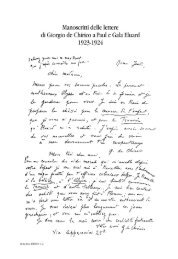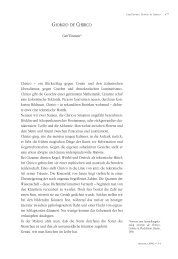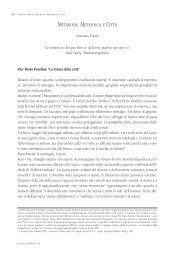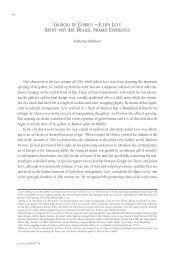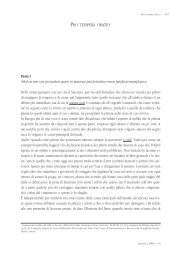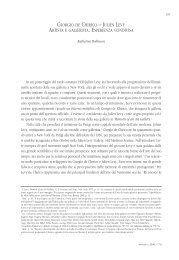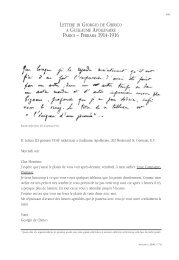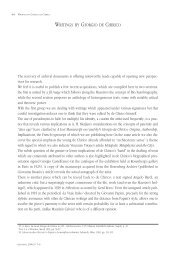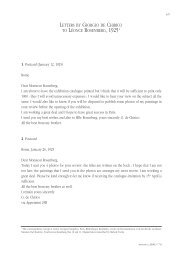Emplastic Oil - Fondazione Giorgio e Isa de Chirico
Emplastic Oil - Fondazione Giorgio e Isa de Chirico
Emplastic Oil - Fondazione Giorgio e Isa de Chirico
You also want an ePaper? Increase the reach of your titles
YUMPU automatically turns print PDFs into web optimized ePapers that Google loves.
SALVATORE VACANTI: FROM MURAL PAINTING TO “EMPLASTIC OIL”<br />
179<br />
The importance of veiling and the need for a rapid technique for applying the paint are emphasised<br />
here. The latter must be achieved with a fluid brushstroke, which, however, must not diminish<br />
the plastic effect. It was for this reason that <strong>de</strong> <strong>Chirico</strong> pursued his search for a new medium, to<br />
which end he read historic treatises such as Mérimée’s book, where the term huile emplastique 90 is<br />
used as a second name for litharge varnish, mainly termed Vernis <strong>de</strong>s Italians Mérimée argues that<br />
this varnish had been utilized in Italy since Antiquity and that it was both very siccative and did not<br />
drip, as liquid veilings had a ten<strong>de</strong>ncy to do. 91 De <strong>Chirico</strong> recalled the painting Autoritratto nudo 92<br />
(Naked Self-portrait) (fig. 12), as being “the most complete painting I have executed so far”, painted,<br />
as it was, with his “emplastic oil”. The work was later inclu<strong>de</strong>d in <strong>Isa</strong>bella Far’s bequeathment<br />
to Rome’s Galleria Nazionale d’Arte Mo<strong>de</strong>rna.<br />
The concentrated artistic and theoretical work of these years is recor<strong>de</strong>d with great irony in his<br />
second fascinating novel Il Signor Dudron (Mr. Dudron). The writing of this book was long and<br />
tortuous, and its final version was only published posthumously. 93 The text represents one of the<br />
fruits of <strong>de</strong> <strong>Chirico</strong>’s literary enterprise, which began in 1929 with the metaphysical masterpiece<br />
Hebdomeros. Conceived as a unique mix of biography and art theory, his second novel brings to<br />
light a new realism imbued with narrative and ironic implications. The protagonist is the painter<br />
Dudron, <strong>de</strong> <strong>Chirico</strong>’s alter-ego, whose story plays out the author’s theoretical examination of the<br />
issue of the material substance of paint.<br />
Having already enabled <strong>de</strong> <strong>Chirico</strong>’s revelation on “beautiful matter” whilst standing before a<br />
Velázquez painting at the Louvre, <strong>Isa</strong>bella also found herself playing the role of the philosophical<br />
Muse to whom <strong>de</strong> <strong>Chirico</strong>-Dudron posed their questions in the novel. Through these discussions<br />
the author <strong>de</strong>velops the themes around which the final version of the work is centred: “beautifully<br />
tinted matter”, the problem of “craft” and technique, and the anti-mo<strong>de</strong>rnist polemic. Compared to<br />
the Small Treatise the text contains additional information related to the results of the research carried<br />
out by the author with <strong>Isa</strong>bella in the 1930s in Parisian libraries.<br />
In a significant episo<strong>de</strong> of the novel, <strong>de</strong> <strong>Chirico</strong> ironises about painterly emulsion in a scene<br />
where Dudron is invited to dinner and his host tells him:<br />
“I am getting ready to make mayonnaise […], it is an extremely <strong>de</strong>licate operation but you shall see<br />
what a masterpiece I am going to create.” I approached the table with foreboding. My friend cracked<br />
the eggs and ad<strong>de</strong>d the olive oil in small quantities all the while mixing with a fork: “it’s the principal<br />
90<br />
The term emplastico is found in the Italian and French dictionary and originates from the Greek word emplastikos (ready to mould). It refers to a substance<br />
that has the same characteristics as poultice, which is consistent and agglutinating and easily adheres to surfaces. The <strong>de</strong>finition of “emplastic oil”<br />
as a paint bin<strong>de</strong>r does not appear in the literature on the history of artistic technique, except in Mérimée and in <strong>de</strong> <strong>Chirico</strong>, who transforms its meaning.<br />
91<br />
See J. F. L. Mérimée, op. cit., pp. 65-67.<br />
92<br />
G. <strong>de</strong> <strong>Chirico</strong>, Autoritratto nudo, 1942-43, oil on canvas, 60.5x50 cm, Galleria Nazionale d’arte Mo<strong>de</strong>rna, Rome. Although the painting is signed “G.<br />
<strong>de</strong> <strong>Chirico</strong> 1945”, it seems more plausible that it was painted in 1942-43. During this period <strong>de</strong> <strong>Chirico</strong> was living with Bellini and was experimenting<br />
with emplastic oil, as recor<strong>de</strong>d in his Memoirs. The figure was originally nu<strong>de</strong>. The loincloth was ad<strong>de</strong>d for the exhibition at the Royal Society of<br />
British Artists in 1949 in London. See <strong>Giorgio</strong> <strong>de</strong> <strong>Chirico</strong> nelle collezioni <strong>de</strong>lla GNAM, cit., pp. 64-65; De <strong>Chirico</strong> e il museo, cit., p. 107.<br />
93<br />
The first fragments of the novel were published in 1940 in two Italian magazines, whilst the first edition was published in 1945 in Paris. It was probably<br />
after this date <strong>de</strong> <strong>Chirico</strong> introduced the figure of <strong>Isa</strong> as inspirational Muse, through whom he gave the theoretical discussions in the novel. He continued<br />
to work on the novel, without ever producing a <strong>de</strong>finitive version. It was finally published posthumously by <strong>Fondazione</strong> <strong>Giorgio</strong> e <strong>Isa</strong> <strong>de</strong> <strong>Chirico</strong>. See G.<br />
<strong>de</strong> <strong>Chirico</strong>, Il Signor Dudron, edited by P. Picozza, J. <strong>de</strong> Sanna, Le Lettere, Florence 1998. Now in G. <strong>de</strong> <strong>Chirico</strong>, Scritti/1…, cit., pp. 161-263, 943-946.<br />
METAPHYSICAL ART 2010|N° 9/10


